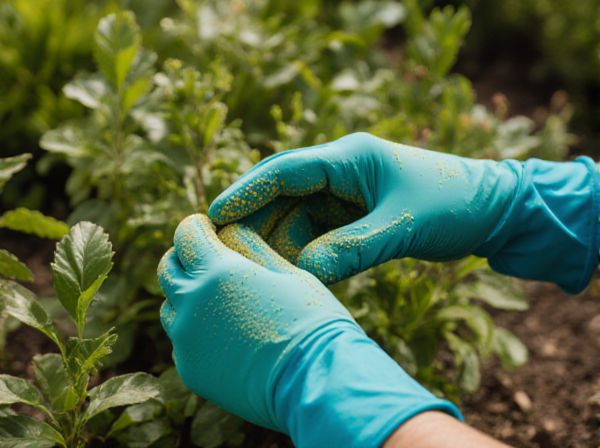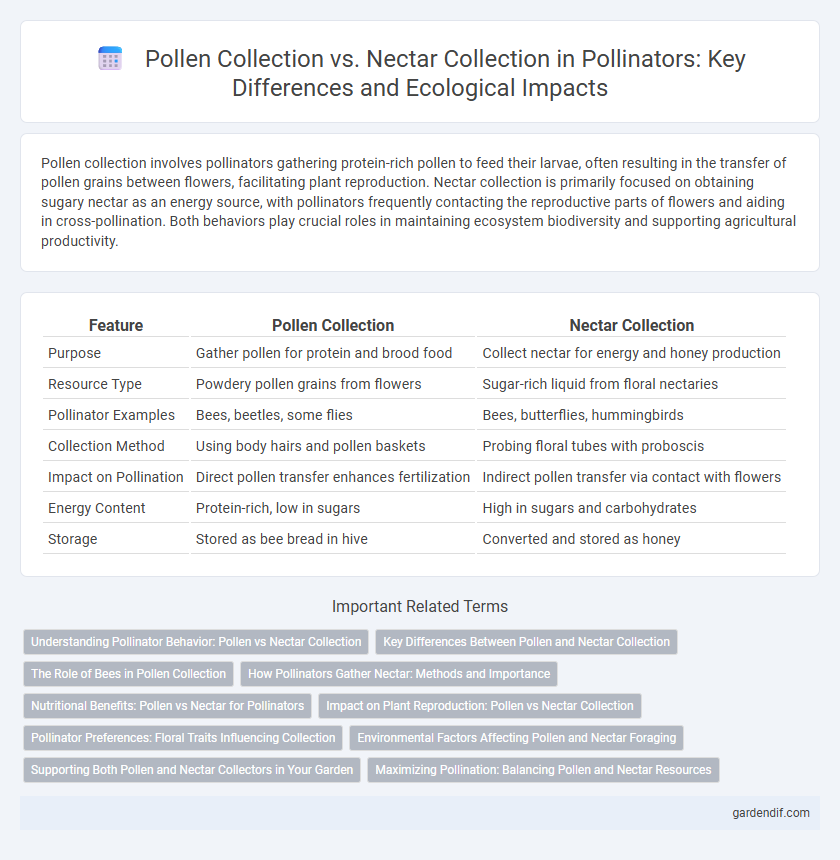
Pollen Collection vs Nectar Collection Illustration
Pollen collection involves pollinators gathering protein-rich pollen to feed their larvae, often resulting in the transfer of pollen grains between flowers, facilitating plant reproduction. Nectar collection is primarily focused on obtaining sugary nectar as an energy source, with pollinators frequently contacting the reproductive parts of flowers and aiding in cross-pollination. Both behaviors play crucial roles in maintaining ecosystem biodiversity and supporting agricultural productivity.
Table of Comparison
| Feature | Pollen Collection | Nectar Collection |
|---|---|---|
| Purpose | Gather pollen for protein and brood food | Collect nectar for energy and honey production |
| Resource Type | Powdery pollen grains from flowers | Sugar-rich liquid from floral nectaries |
| Pollinator Examples | Bees, beetles, some flies | Bees, butterflies, hummingbirds |
| Collection Method | Using body hairs and pollen baskets | Probing floral tubes with proboscis |
| Impact on Pollination | Direct pollen transfer enhances fertilization | Indirect pollen transfer via contact with flowers |
| Energy Content | Protein-rich, low in sugars | High in sugars and carbohydrates |
| Storage | Stored as bee bread in hive | Converted and stored as honey |
Understanding Pollinator Behavior: Pollen vs Nectar Collection
Pollinators exhibit distinct behaviors when collecting pollen versus nectar, each serving unique roles in plant reproduction and ecosystem health. Pollen collection primarily supports the nutritional needs of pollinators and facilitates cross-pollination, enhancing plant genetic diversity and crop yields. Nectar collection drives energy intake and pollinator movement patterns, influencing pollination efficiency and the spatial distribution of pollinated plants.
Key Differences Between Pollen and Nectar Collection
Pollen collection involves gathering protein-rich grains from flowers, primarily used to feed brood and support colony nutrition, whereas nectar collection focuses on harvesting sugary liquid for energy production and honey creation. Pollen is collected with specialized structures like scopae or corbiculae on pollinators' legs, while nectar is accessed via a proboscis to extract fluid from floral nectaries. Unlike nectar, which is a liquid carbohydrate source converted into honey, pollen provides essential amino acids, lipids, and vitamins critical for insect development.
The Role of Bees in Pollen Collection
Bees play a critical role in pollen collection by actively gathering pollen grains from flowers using specialized structures called scopae or pollen baskets on their hind legs. Pollen collection is vital for bee colonies as it provides essential proteins and nutrients required for brood development and hive growth. While nectar collection primarily supplies bees with carbohydrates for energy, pollen collection is integral for sustaining colony health and ensuring effective pollination of flowering plants.
How Pollinators Gather Nectar: Methods and Importance
Pollinators gather nectar by extending their proboscis into flowers, efficiently extracting sugary fluids vital for energy and survival. Different species utilize specialized methods; bees lap nectar using hairy tongues, while butterflies suck it through long, coiled proboscises, optimizing nutrient intake. Nectar collection not only fuels pollinators but also facilitates pollen transfer, ensuring reproductive success and biodiversity in ecosystems.
Nutritional Benefits: Pollen vs Nectar for Pollinators
Pollen provides essential proteins, lipids, vitamins, and minerals critical for the growth and development of pollinators, supporting immune functions and reproductive success. Nectar, primarily composed of sugars like glucose, fructose, and sucrose, offers a quick energy source vital for flight and daily activities. While nectar fuels immediate energy needs, pollen supplies the macronutrients necessary for long-term health and colony sustainability in pollinator species such as bees.
Impact on Plant Reproduction: Pollen vs Nectar Collection
Pollen collection directly influences plant reproduction by facilitating fertilization and genetic diversity through the transfer of male gametes. Nectar collection primarily attracts pollinators, indirectly supporting plant reproduction by increasing visitation rates and pollen dispersal efficiency. The balance between pollen and nectar collection impacts reproductive success and plant population dynamics.
Pollinator Preferences: Floral Traits Influencing Collection
Pollinators exhibit distinct preferences for pollen or nectar based on floral traits such as color, scent, and morphology, which directly influence their foraging behavior. Flowers producing abundant, protein-rich pollen often attract bees specializing in pollen collection, while those with high nectar volume and sugar concentration tend to entice butterflies and hummingbirds. The interaction between floral reward type and pollinator sensory cues shapes pollination efficiency and plant reproductive success.
Environmental Factors Affecting Pollen and Nectar Foraging
Environmental factors such as temperature, humidity, and floral resource availability critically influence pollen and nectar foraging behaviors in pollinators. High temperatures and low humidity often reduce nectar secretion in flowers, driving pollinators to prioritize pollen collection for protein needs. Conversely, abundant floral nectar under optimal conditions encourages nectar foraging to meet energy requirements, highlighting the dynamic impact of environmental conditions on pollinator foraging strategies.
Supporting Both Pollen and Nectar Collectors in Your Garden
Creating a garden that supports both pollen and nectar collectors involves planting a diverse range of flowering plants that bloom at different times, ensuring continuous resources for various pollinators. Incorporate native wildflowers, fruit trees, and herbs to attract bees that collect pollen for protein and others that gather nectar for energy. Providing water sources and avoiding pesticides further enhances the habitat, promoting healthy pollinator populations essential for plant reproduction and ecosystem balance.
Maximizing Pollination: Balancing Pollen and Nectar Resources
Maximizing pollination requires a strategic balance between pollen collection and nectar gathering, as pollen serves as a vital protein source for pollinators while nectar provides essential energy through sugars. Bees adapt their foraging behavior to optimize resource intake, often targeting flowers that offer both abundant pollen and nectar to enhance pollination efficiency. Effective pollination management involves cultivating diverse plant species that supply complementary pollen and nectar resources, promoting robust pollinator activity and improved crop yields.
Pollen Collection vs Nectar Collection Infographic

 gardendif.com
gardendif.com